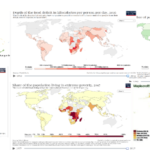Fred Carden
Coherence: A Principles-Focused Approach
- What is Coherence?
- OECD 1991 – initial focus on policy coherence
- European Commission 1992 – put into law
- Focus has been on global issues
- Enshrined in SDGs
- No accepted definition
- OECD defines coherence as: an approach and policy tool to systematically integrate the economic, social and environmental dimensions of development at all stages of domestic and international policy analysis.
- What is Coherence in a Country Program?
- Development, Trade, Diplomacy – how are they coherent?
- There are different levels of coherence: 1) Internal Coherence; 2) Intra-Organizational Coherence; 3) Inter-Organizational Coherence; 4) International Coherence
- Focus of Global Affairs Canada in Columbia case was on first two levels of coherence
- We first looked at the notion that coherence is not only about policy – what does coherence mean in the context of programming of global affairs in Columbia?
- Levels of Coherence
- Policy Coherence
- Organizational Coherence
- Administrative Coherence
- Knowledge Coherence
- Informal Coherence
- Measuring Coherence
- Developed four-level rubric – no coherence to coherence
- Breaking it up into different elements very helpful in discerning what was/was not coherent – Example: coherence across international assistance; coherence across international engagement
- Found that there was pretty good policy coherence, but administratively weak
Lori Bell
- In the context of UNHCR commissioned evaluations, coherence is always looked at through the lens of relevance – are we doing the right thing?
- Presentation provides concrete examples of evaluations where coherence was looked at from an internal and external point of view
System-wide evaluation of cyclone Idai Mozambique 2019
External Coherence
- Complexity, crowdedness of the humanitarian space
- The divide and conquer of different agencies
- How did we live up to our responsibilities and roles compared to what other actors did?
- If you want to look at External Coherence, you can’t do it on your own – we need to understand the comparative advantage of UNICEF, etc.
- We need to know a lot about other agencies operations and what the government is doing
- Inter-agency joint evaluation, rather than a single agency evaluation
The Importance of Personalities, Perceptions, and Culture
- Coherence boils down to individual behaviours and decision-making on the ground
- We need to look at culture and perceptions
Elliot Stern
Aspects of Policy Coherence
- ‘Policy Coherence’ in EU and OECD
- Coherence now a “new” (2020) OECD criteria, but entered European policy vocabulary in 1992 Maastricht Treaty
- Distinction between internal and external coherence – i.e., consistency of elements making up a policy action vs consistency between different policy actions (this distinction may be less clear-cut than 10 or 20 years ago)
- 4 Aspects of Contemporary Policy Coherence
- Unit of analysis
- Growing understanding of complex and interdependent policy priorities (e.g., innovation, climate change mitigation, equity and justice)
- Extending the Unit of Analysis: i) decontextualized policy interventions (coherent with policy inputs); ii) contextualized policy interventions (coherent with policy/non-policy inputs/contexts); iii) interdependent policies interventions (coherent between multiple policies in multiple contexts); iv) policy systems (many coherence possibilities)
- Systems Mapping for complex policy evaluation
- Coordination and governance – Coherence doesn’t happen on its own!
- Multi-part and separate but interdependent policy interventions must be aligned – importance of coordination and governance arrangements
- Success often depends on pre-existing community, sectoral/territorial networks; credibility of system leaders; capacities to use information and adapt; participatory engagement of stakeholders
- Coordination and governance itself must be evaluated – part of ToCs, etc.
- Encouraging those in governance and coordination roles to reflexively learn and generate and use M&E data a way of strengthening coherence
- Timing: Re-setting the evaluation clock
- Move away from short-run, ex-post evaluation at end of program/policy cycle to integrate evaluation into program planning and “up-valuing” mid-term/ongoing evaluations
- Ex-post evaluations are moving long-term – look back over longer time scales on rolling basis
- Mid-term evaluations increasingly inform reprogramming and “steering” and adaptive management
- Importance of substantive theory
- When we move from narrow focus on programs to recognize importance of complexity, context and interdependencies, it changes where we look for theory
- Program theory is not enough
- Becoming standard in UK and EU structural funds to look to academic research to identify building blocks of Theories of Change (e.g., Innovations Systems Theory)
- Centrality of literature reviews and partnerships with domain experts
- Unit of analysis
Vijayalakshmi Vadivelu
UNDP’s programming:
- In past 3 decades, programs have looked at coherence in different program areas – support to livelihoods, peace building, etc. require synergies – intersecting elements to enhance coherence at the country level
- UNDP’s consistent emphasis on coherence and partnerships – implemented with a range of partnerships – integrated role within UN system
- Programming at national and subnational levels enables synergies/linkages
Coherence a key dimension of program performance
- Assessed at multiple levels: Internal, External, Intra-organizational
- Mapping of areas where maximum synergies are possible
- Also look at intersecting areas in response to crises
External Coherence
- UNDP collaborates with other actors to contribute to humanitarian response
- Determine pathways that link, map key actors working in the area, identify intersecting process indicators and strength of partnerships
- In bringing together different actors, coherence assessed using sector data
- Increasing household income, increased investment = indicators for policy coherence
Different types of Coherence – horizontal and vertical pathways
- We try to determine the level of coherence
- Questions regarding linkages to sustainability
- Use causal pathways through the Theory of Change – coherence is one we try to examine
- Multiple methods – determining coherence is more challenging, especially subjectivity in identifying some of the indicators, even where synergies are happening
- Can be helpful to disaggregate and then develop a composite score
- For each level, we use a different rubric for mapping
- Determining national sector policy coherence is often much simpler, but determining the contribution of an agency/program can be extremely challenging



Leave a Reply